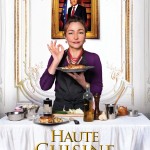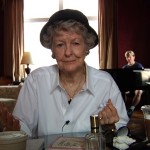By Phillip D. Johnson
As a first-time attendee to the Tribeca film Festival in Downtown New York City, I didn’t quite know what to expect but I ultimately came away from the experience more educated–and entertained–than I thought I would. The whole experience, in and of itself, was an eye-opener for me. And based on conversations with TFF veterans, this was the best year yet for the festival. Even as a first-timer, I have to agree. The Village Voice said of the festival: “Tribeca is finally up and running…This is the second year of the tenure of Artistic Director Frederic Boyer, formerly programmer of Cannes’s Directors Fortnight sidebar, and the mix-more than 100 films-appears to be broadening and deepening…There’s a wealth of under-the-radar riches here.”
From over 6,121 submissions (feature films, documentaries, narratives and shorts), there were–in the feature film section–53 world premieres, 6 international premieres, 15 North American premieres, 5 U.S. premieres, and 9 New York premieres, with 12 documentaries, 12 narrative films and 24 feature films in competition. In the Short Film Section, there were 30 world premieres, 6 international premieres, 8 North American premieres, 3 U.S. Premiere and 13 New York premieres. The festival featured the works of 38 first-time directors (including actor Clark Gregg who starred in and directed Trust Me, and Whoopi Goldberg, who produced and directed I Got Somethin’ to Tell You), 11 first-time female directors, 27 first-time male directors, 114 feature length directors, 10 returning directors and a special screening celebrating the 30th anniversary of Martin Scorsese’s newly restored ‘The King of Comedy’ closing the 12th annual Festival.
Of course, much like the semi-annual New York Fashion Week at Lincoln Center (and other venues around town), it was a case of too many films (or fashion shows) you want to see and too little time to see them all. Starting at 9:45 am every morning, I managed to see as many as I could and the following were my favorites and the films and documentaries that have stayed with me even now.
HOW TO MAKE MONEY SELLING DRUGS (2012, 100 minutes, Director: Matthew Cooke) At first blush, I think I know what this documentary was going to be about. But then I was very pleasantly surprised just the same. This sneakingly shocking and candid documentary took me to places I least expected but was glad to go to anyways. How to Make Money Selling Drugs was a blunt but highly entertaining examination of how a street dealer can rise to cartel drug lord with somewhat relative ease. The movie examined the whole U.S. War Against Drugs from the viewpoints of former (retired) drug dealers, DEA agents, defense lawyers, prosecutors and politicians who used the misguided war against drugs and egregious drug laws to get (and stay) elected, addicts, innocent people whose lives were nearly destroyed by the drug culture and rights advocates such as actors Susan Sarandon and Woody Harrelson. Some things I already knew (example: that law enforcement –police departments across the land– liberally uses the search and seizure laws to confiscate drug dealers’ properties, which they then sell at auction and use the proceedings to balance their respective yearly operating budgets; that police misconduct–missing drugs from drug busts and police station evidence lockers, false drug arrests, corrupt cops who become drug dealers themselves– has arisen across the country as a result). Other facts that came out of the film were not surprising but very, very disturbing: the ineffective war on drugs is not only a MAJOR EPIC failure but equally that the United Sates government itself is indeed the biggest illegal drug dealer of them all. Why am I not surprised? If you ever get a chance to see this film, make it a priority to do so.
WHAT RICHARD DID (Ireland, 2012, Director: Lenny Abrahamson, Screenwriter: Malcolm Campbell) Based on a book (BAD DAY IN BLACKROCK) by Irish writer Kevin Power, WHAT RICHARD DID, is an engrossing story of lust, love, rampant jealousy, drunken rage, and the unforeseen consequences of it all. The world is bright and full of promise for Richard Karlsen (JACK REYNOR), the golden boy of his privileged set of Dublin teenagers spending a lazy summer between their graduation from high school and before they all head off to college in the fall. What could possibly go wrong? Plenty, unfortunately. Richard first met Lara (ROISIN MURPHY) at a party on the seashore and fell instantly in lust. Although she’s already seeing someone (Conor, played by SAM KEELEY), eventually they hooked up and became a couple. It all came crashing down at a house party where Richard, consumed with jealousy over Lara’s continued friendship with Conor, allowed that jealousy to broil over into a drunken brawl (ending with a kick to Conor’s head, from Richard) that resulted in his death. This was the beginning of the end, as they say. This senseless, unintended act resulted in broken friendships (one of his closest friends, while swearing to stick to the party line, told him not to call or talk to him anymore), broken trust (he was sent away from his family home after confessing to his father), broken relationships (Lara also cut him out of her life), general anguish and emotional pain; and it shattered the lives of the people around him. There is not one false performance in this movie. Everyone in this largely young cast performed to their highest level, especially Jack Reynor (who will next be seen in the upcoming Transformers sequel). This movie particularly resonates with me because director, Lenny Abrahamson, helmed a movie that was expertly paced in a restrained manner, leaving the actors to tell the story through their powerful performances. What I appreciated the most is that the movie ended in a way that was most realistic and true to life. There were no heroes and most everyone concerned shared the role of being the villain. WHAT RICHARD DID is presently playing at theaters in New York City and will be a featured film at the 2013 Sydney Film Festival this June in Australia.
TEENAGE (WORLD PREMIERE, documentary, 2013, Director: Matt Wolf, Screenwriters: Matt Wolf & Jon Savage) Until 1950, the term teenager was not in general use. You were either a child or you went to work as an adult. Children were otherwise known as girls and boys were called youths once they displayed signs of puberty. Then young people were grown up at 18 and fully adult legally at 21 when they often married and set up a home of their own even if it was rented room. Getting married was a way of showing the adult world that you belonged to their world and was a way of escape from puberty.
During the 1950s a range of influences including film, television, magazines and the rock music scene created a new market grouping called teenagers. A sudden flurry of consumer goods denied to war torn Europe were available and a consumer boom was actively encouraged. Teen clothes, which were specifically intended to be bought by teenagers, became available. These single young people with cash from paid work soon had their own fashions, own music, own cafes, own milk bars and by the end of the decade even their own transport in the form of fuelled scooters. Teenagers suddenly dominated style in clothes, haircuts and even travel abroad. A generation gap began to emerge between parents and teen offspring. It seemed almost unholy at the time and was viewed as rebellious, but compared to later anti-fashion and anarchic movements –and even what came before 1950– it was all rather innocent.
Inspired by Jon Savage’s book, TEENAGE, Matt Wolf’s absorbing documentary, TEENAGE, tells the story of young people from the first half of the 20th Century in the United States, England and Germany and is a fascinating look at the pre-history of youth culture before “teenagers” became a marketing focus group. Mr. Savage and Mr. Wolf seamlessly created “living collages” of the lives of children after child labor was abolished, using archival newsreels, amateur movies, feature film clips and photographs. They juxtaposed quotes from hundreds of diaries alongside the abovementioned archival materials to mirror the generational tension that drives the story, thus making for a film that held my interest from beginning to end. Four voices (Jena Malone, Ben Whishaw, Julia Hummer and Jessie Usher) bring to life the portrait of youth from the past: Brenda Dean Paul (a self-destructive Bright Young Thing), Melita Maschumann (an idealistic Hitler Youth), Tommie Scheel (a rebellious German Swing Kid) and Warren Wall (a black Boy Scout). Because I believe that you learn something new every day, I learned a lot from this film. I was most interested in the story of Tommie Scheel, who was discovered in Michael H. Kater’s book, DIFFERENT DRUMMERS, a cultural history of swing and jazz music in Nazi Germany. As a member of the Hamberg Swings, Scheel rebelled against the Nazi regime; and he and his friends ultimately paid the price for their rebellion. It was interesting because we all knew about the Nazi Youth movement but who knew about the German Swing movement? I didn’t. It also proved the point that even without a name, youthful rebellion carried the day. While I found the documentary to be quite good, I wished that director Matt Wolf would have made some mention of the beginning history of teenagers (in the 1950s) at the top of the film. It was as if he buried the lead in an otherwise interesting long form magazine article.
HAUTE CUISINE (France, 2012, English & French with subtitles, Director: Christian Vincent, A Weinstein Company Release) I am huge fan of cookbooks (I read them for fun), the Food Network (when it actually was about food and not so much about food/chef competitions) and food movies. I laughed, salivated and cried my way through Like Water For Chocolate, Babette’s Feast, Julie & Julia, Chocolat (2000), Big Night (1996), Eat Drink Man Woman, Fried Green Tomatoes, Pieces of April (the best movie Katie Holmes ever made before she went down the rabbit hole with Cruise and Scientology) and many other movies where food (and its preparation) played a major role. Based on the real life story of the personal chef to former French President François Mitterand, HAUTE CUISINE used the politically charged corridors of Elysee Palace to tell the story of the equally politically charged atmosphere of the Palace’s kitchen and its male dominated world. As the chef-owner of a modestly successful provincial restaurant, Hortense Laborie (CATHERINE FROT) was not expecting to be called on by the French president to act as his personal chef. Filled with trepidation, she nonetheless took the job. Once she took the job, she found herself fighting not just the president’s men but the snobbish all-male old guard kitchen staff as well. From the beginning, they attempted to sabotage her at every turn; and only by going directly to Mitterand herself were she able to cut off the head of the snake and push back at their malicious interference. Through it all, Laborie proved that she can take the heat of the kitchen and whatever hazing the male chefs of the kitchen dished out. At a fast-paced 95 minutes, HAUTE CUISINE tells a fully developed story that draws you into the main character’s soul. Her pain becomes your pain. Her triumphs become your triumphs. Her tears becomes your own. Alongside Miss Frot, eighty-seven year-old accomplished writer JEAN D’ORMESSON makes his film debut as Francois Mitterand and gave a stirring performance. HAUTE CUISINE is set for wide release in the United States in the coming months.
THE DIRECTOR (Italy/USA, 2013, English & Italian with English subtitles, Director: Christina Voros, Migrant Turtle Films) I am the hugest fan of fashion-themed movies and documentaries. Even the truly terrible ones such as Prêt-a-Porter. Some of my favorites includes Funny Face, Ultrasuede: In Search of Halston, Valentino: The Last Emperor, Coco before Chanel, Lipstick (1976), The Women (the original, not the bastardized version from the mid-2000s), The September Issue, Unzipped, Mahogany and now, The Director, a film directed by Christina Voros and produced by actor/director/artist/jack-of-all-trades James Franco, Miles Levy, Vince Jolivette & Christina Voros. THE DIRECTOR: AN EVOLUTION IN THREE ACTS is the behind the scenes story of Gucci Creative Director, FRIDA GIANNINI and her work on collections over three consecutive seasons (18 months) for the House of Gucci. In exploring Giannini’s work (through film), Voros discovered that “Frida is a brilliant designer, but her role requires her to be so much more. She’s a director and this tasks her to be as much of a leader as an artist. It was inspiring to be a fly on the wall inside her house, and it taught me a great deal about myself and the balance of creativity and leadership in my own process as a director in a different medium.”
As someone with some knowledge of how the fashion design business works, I went to the screening knowing some of the variables and expecting to be educated on the rest. And I was. As a leader, Giannini displays the right amount of business toughness mixed with an equal amount of warmth and caring for her employees. She knows what she wants and expects from the people around her and is quite decisive in her decision-making. A ‘no’ is a ‘no,’ not a ‘maybe’. If it’s not what she requested, don’t argue; just make it right. And to some extent, all decisions are finals. On the other hand, she also displayed a great sense of humor, was quite down to earth and has a good sense of self. As she so eloquently put it, “I suppose I agreed to do this because I think the glamour of the fashion industry conceals the hard work that goes into the process itself and for an 90-year-old fashion house like Gucci there is so much that goes into the ‘making of’ our products and collections that deserves to be better understood, so I thought it would be interesting to have an outsider’s view on the complete story.”
Even better for the viewer and the industry (on a whole), this is not yet another documentary about yet another egomaniacal, out-of-control fashion person terrorizing the lesser lights around her, a la The Devil Wears Prada. This is simply the story of a woman working to keep all the balls in the air with the goal of achieving success at the end of the line, something all women can relate to.
IN GOD WE TRUST (USA, Documentary, Directors/Screenwriters/Producers: Victor Kubicek & Derek Anderson, Co-Producers: Hunter Gray & Orlando Wood) Bernie Madoff is presently serving a 150-year sentence but much like herpes, he’s the gift that keeps on giving. IN GOD WE TRUST, we follow Madoff’s longtime secretary, Eleanor Squillari, as she attempts to unearth the truth behind the biggest Ponzi scheme ever perpetrated on the world. For twenty-five years, she sat fifteen feet from Bernard L. Madoff as his personal secretary; and on December 11, 2008, her world came crashing down around her. Since then, she has made it her life’s work to finding out the truth about what happened; and in this must-watch documentary, we follow her journey as she tries to reconstruct the pieces of the scheme to better understand it herself and to help all the people who lost their lifesavings and pensions as a result of Madoff’s actions. By going back into her files and interviewing journalists and others, she joined forces with the FBI and discovered so much more than she anticipated. Just when you think you know all there is to know about this tragedy, you find out that you don’t. Ms. Squillari, through her work and conversations with others, laid bare the destruction in infinite details; and we learn the real truth of this crime, including who was involved, who benefited and who was the likely mastermind behind it all. If anything, this documentary is very much a cautionary tale: If it looks too good to be true, then it’s very likely that it is TOO good to be true.
ELAINE STRITCH: SHOOT ME (2013, USA, Director: Chiemi Karasawa, Screenwriter: Chiemi Karasawa 7 Elizabeth Hemmerdinger) Recently, Broadway legend Elaine Stritch moved back home to Michigan after years of living (and working) in New York City, becoming one of the City’s Living Legends. But before she left, she and Karasawa gave us one last gift: ELAINE STRITCH: SHOOT ME, an engrossing look at Miss Stritch as she took her show on the road for one last time. In this film, she was very much more I expected. At times, she was wickedly funny (”Your camera is awfully close. Is this a skin commercial?”), breathtakingly vulnerable, brutally frank (“Everybody’s got a sack of rocks.”), and just so very much alive. Partly because licensing film clips for an independent project can be prohibitively expensive, Karasawa decided to focus on Stritch in the here-and-now because “after spending even a small amount of time with Elaine Stritch, I became more interested in following her in her day to day life, just exploring what it was like to someone at her age, still working, very solidly, as a performing artist. Even at this age, she’s still in full force.”
The most heartbreaking moment in the film came when Stritch (who has Type 1 Diabetes) has a severe hypoglycemic attack the day before a concert. I can honestly say that I felt every bit of pain and anxiety she was feeling. It was a powerful part of the film because it showed her vulnerability and another side to the actress/singer we never knew about. The diabetes also affected her memory, which we saw in rehearsal as she struggled to learn the lyrics to new songs. As her musical director Rob Bowman explains, “she has this incredible way to work it in [during performances], to the point that people think it was a part of the show. It just becomes this incredible piece of ad-libbing.”
I have long admired Elaine Stritch and her work. She’s my ‘Auntie Mame’. I am very glad I made the time to see this film because it gave me a greater understanding of the woman, the artist, the icon. I leave you with the following words from Karasawa: “[Elaine] has this infectious thing about her – it’s like a disease. Once you’ve spend enough time around her, all you want to do is hear her tell stories and talk about funny things that happen when she’s around. Elaine is a singular personality. She’s always interesting, even when she’s not trying to be.” Amen to that.
The Tribeca Film Festival always has a strong slate of Lesbian/Gay/Bisexual/Transgendered films and this year was no exception. FLOATING SKYSCRAPERS (2013, Poland, Director: Tomasz Wasilewski, Polish with English Subtitles) tells the age-old story of finding love in all the unexpected places with a honesty and depth that kept me captivated from beginning to end. Much like my other top favorite LGBT film, SHELTER (2007, directed by Jonah Markowitz), FLOATING SKYSCRAPERS speaks to the power of being true to one’s self because, as everyone knows, at the end of the day, whatever the issue, that’s the only thing that really matters. BRIDEGROOM (2013, USA, Director: Linda Bloodworth Thomason) is a deeply personal look at the ongoing debate over the legal rights of same-sex couples using interviews, photos and video footage to testify to the emotional journey of Shane and Tom, two young men in a loving and committed relationship. When a tragic accident cut Tom’s life short, Shane finds himself facing the failure of marriage protections, leaving him completely shut out. Whatever your feelings are on the issue, BRIDEGROOM will serve to shed new light on the often-overlooked struggles that same sex couples face as a result of marriage inequality.
On a lighter note G.B.F. (2013, USA, Director: Darren Stein) is a comedy/drama that brought a bit of levity to the schedule. The bitter fight for top dog status between the three most popular girls at North Gateway High takes an unexpected twist when their classmate, Tanner, is outed and became the only openly gay student. The trio raced to bag the latest trend in fashion accessories: The Gay Best Friend, with all the ensuing drama (and comedy) that comes with it. With memorable cameo appearances by Meagan Mullally, Natasha Lyonne, Jonathan Silverman and Rebecca Gayheart, G.B.F. is the heir to all the teen movies we loved when we were growing up. It’s MEAN GIRLS THE BREAKFAST CLUB, PRETTY IN PINK and EASY A all mixed in one. It’s not a perfect film but the dialogue is quite snappy and quotable, the young actors are competent and the costumes are, as a friend of mine say, to die for.






































